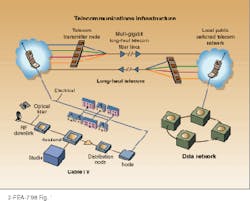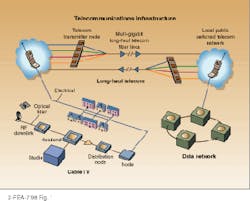How lithium niobate meets telecommunications needs
How lithium niobate meets telecommunications needs
When regarded as a technology platform, lithium niobate can add value to optical networks through higher levels of component integration.
Mark Thompson
Three decades ago the convergence of key enabling technologies started a booming electronics industry. Today, as the photonics industry matures, a similar convergence of key technologies is pushing optical communications into a new era. Exploding demand for network bandwidth during the past two years has resulted in the emergence of first-generation wavelength division multiplexing (WDM) technology--WDM is now being deployed in telecommunications networks across the globe to address the need for quick capacity upgrades on key existing telecommunications routes that are short on available fiber (see Fig. 1).
With WDM transmission, network planners can upgrade capacity without disrupting their ongoing goal of on-time cost-effective service delivery. Meantime, equipment makers are developing a range of platforms to allow telecommunications systems to evolve toward all-optical network switching. The element common to such strategies is that the carriers do not want to slow evolution of the network of tomorrow by making wrong hardware deployment decisions today--carriers must choose equipment today, without prior knowledge of the network of tomorrow.
The performance of an all-optical network is determined primarily by the installed fiber. Older fiber networks are typically dominated by standard fiber, taking advantage of lower fiber cost and zero dispersion in the 1300-nm-wavelength window. Newer networks, however, are likely to be based on low-loss dispersion-shifted fibers and to benefit from use of erbium-doped fiber amplifier optical amplification. The transmission equipment manufacturer must offer customers the greatest return on investment in the installed fiber plant and transmission/switching equipment. Wavelength division multiplexing currently offers the best value increase in information capacity for capital investment outlay, and the extra revenues generated by the added bandwidth further fuel network expansion.
The costs of running a network are dominated by the number of switching nodes and amplification sites. The best cost efficiencies result from investing in equipment that reduces network management overhead. Traditionally this has meant progressively increasing the span between amplifier stations and switching nodes, which has been achieved by improving optical transmission equipment capabilities. Transmission spans are now so great that fiber dispersion is the performance limiter in many optical trunk networks. Hence, transmission designs that provide the greatest opportunity for optical power and dispersion management will be the winners in the all-optical network. Reducing both the amount of equipment and improving management simplicity will yield significant cost efficiencies. The consensus of opinion from service providers recently at a WDM conference in England was that the low-cost optical backbone network will be provisioned by fewer network nodes and progressively more sophisticated transmission technologies.1
Modulation technologies
As networks centralize, optical spans will increase, and the cost of optical power and dispersion management in WDM transmission systems becomes dominated by the choice of optical modulation applied. There are three major modulation technologies determining various grades of distance/bandwidth performance--direct laser modulation, electro-absorptive laser modulation, and external modulation with lithium niobate (LiNbO3). Comparison of these technologies is strongly applications dependent, so the following comparison is based on performance referenced to the predominant ITU 200-GHz (1.6 nm ) grid wavelength standard and
2.5-Gbit/s transmission rate.
Direct modulation requires thermoelectric cooler stabilization for all but the shortest WDM spans. Uncooled WDM laser technology is appropriate for deployment within a campus application. Cooling the laser generates additional wavelength control, allowing spans to increase. Commercial direct-modulation WDM systems are dispersion-limited to a span length slightly more than 80 km.
This distance can be extended by using electro-absorptive-modulated (EAM) lasers. There are conflicting reports from manufacturers and users on the guaranteed--production quantity--performance of these parts. There is a general consensus that while 200 km can be readily achieved, operation over the highly prized 640-km ITU span has been demonstrated only by a limited number of EAM devices. An attractive feature of EAM is the low electrical drive amplification needed. This benefit is offset, however, by high optical insertion losses, limiting the optical output to the consequence of the need for additional optical gain. This optical gain can easily be provided but incurs some system cost penalty, driven by either the use of additional, more-costly optical amplification or higher-power lasers requiring sensitivity to strict wavelength control demanded by the ITU grid. The major hidden cost of EAM technology is the need to manually fine-tune individual units to an optimum point of operation. The "touch time" and RF skills required to optimize large volumes of product have resulted in limited manufacturing output efficiencies.
As a result of these real-life performance limitations, the market has responded by making external modulation with LiNbO3 the technology of choice in long-haul WDM applications. Lithium niobate is a technology with a broad and well-established application base--it has been widely deployed in a host of high-fidelity analog applications that have been in operation for many years. The true test for optical components is in the ability of the manufacturer to package the working parts to provide the customer with consistent product performance for many thousands of devices. The hundreds of man-years of experience devoted to LiNbO3 optical device development for early space and military applications was a significant factor during the recent commercial realization of the technology (see Fig. 2). The growth in demand for telecommunications bandwidth has created a market ideally suited to the broad-based benefits of LiNbO3, which has so far delivered to the market.
The first generation of LiNbO3 modulators demonstrated multiple-wavelength (2.5 Gbit/s) span distances over 600 km with the need for only five remote amplifiers. To some readers this may seem inconceivable when they recall that, less than a decade ago, such a span required more than 20 regenerating amplifiers per data stream. This example shows what has been achieved in network price and performance improvements. Much more could be achieved in the next ten years if additional benefits of LiNbO3 are fully exploited in the emerging optical layer.
The evolution path
Most current telecommunications applications using LiNbO3 modulators are based on selected discrete components for the optical transmitter subsystem, coupling continuous-wave lasers, modulators, and a number of laser wavelength and power stabilization parts. The reasons for this discrete approach lie in the certainty of each component replicating the performance of the previous one, modular flexibility, low cost, and short-term availability. In all applications the modulator component is used merely as a simple encoder of electrical information onto an optical carrier.
The emerging optical network, however, demands much more than transmission.2 Service providers select network transmission equipment based not only on capacity but on factors such as manageability, protection, scalability, initial deployment cost, granularity, and route diversity.
Lithium niobate can be regarded as a technology platform suitable for addressing these network issues, rather than merely as a discrete component. The real strength of the LiNbO3 technology platform is its ability to add value to the network by migrating to higher levels of optical integration. The benefits should be comparable to the analogy of the discrete transistor, moving to higher levels of integration in silicon substrates.
Lithium niobate has proven suitable for manufacture of spatial switches, phase modulators, amplitude modulators, dispersion compensation devices, polarization scramblers, tunable filters, and wavelength-selective optical add/
drops and cross-connects (see Fig. 3). Each of these functions has significant benefits for the all-optical network. The key element to exploiting them is to understand how a higher level of integration can be applied in the network.
The first step is to improve the end-to-end link performance. Transmission distances can be improved by integrating either a phase modulator or an additional amplitude modulator with the existing amplitude modulator.3 These features can overcome the limitations of polarization-mode dispersion, fiber chromatic dispersion, and gain tilt in optical amplifiers. Combination of multiple-phase and amplitude modulators will offer higher-speed transmission toward 80 Gbit/s, using optical time division multiplexing (OTDM). As each optical carrier is transmitted independently, OTDM can be combined with dense WDM techniques to generate multiple-terabit transmission paths.
Switching and routing is an essential aspect to any network. Integrating spatial switches with phase and amplitude modulators offers convenience and flexibility in an all-optical network. In today`s SONET and SDH networks, switching and routing is done by necessity in the electrical domain. The need to demultiplex traffic to lower levels for switching represents a bottleneck in the network during the time taken to manage the bandwidth allocation. All-optical switching is quicker and eliminates this bottleneck. Optical switching will benefit from the introduction of tunable lasers and tunable filters. These technologies allow dynamic reallocation of bandwidth in the optical domain. The result of this flexibility is simple network-management tools allowing greater bandwidth utilization and network availability. Lithium niobate is currently the only viable modulation technology to take advantage of dynamic wavelength reallocation.
The all-optical network, by its very nature, must be independent of the type of traffic carried. Lithium niobate assists in this transparency because it can be modulated by a host of transmission formats without diminishing system performance. Consider the benefits of a transmission system that can, for example, carry SONET, SDH, ATM, Internet Protocol, Fast Ethernet or some other format without discrimination.
Network protection is essential in modern communications. Lithium niobate can be integrated to offer diverse routing via spatial switches. This can add an additional layer of protection such that a wavelength can be dynamically re-routed off a path if, for example, an unequal amplifier gain profile gives some cause for concern.
The high transmission rates required for optical network efficiencies should not compromise network granularity. The all-optical network must sustain reasonable levels of customer access to bandwidth in order to maintain commercial viability. Higher levels of optical integration allow equipment manufacturers to transfer much of the high-end electrical functionality into the optical domain. As time division multiplexing (TDM) electronics continue to evolve and access bandwidth rates continue to surge, manufacturers can provide greater performance levels within the mechanical constraints of standard telecommunications cabinets.
These are among the many and varied applications whose functionality can be fulfilled by the LiNbO3 technology platform. Service providers considering the next-generation optical network will substantially benefit by the transfer of electronic functionality into higher levels of optical functionality using LiNbO3.
The all-optical network will emerge in response to the market. Bandwidth growth today is driven by business data, telephony, and surging access to the Internet. In the near future, digital access services, multimedia applications, and video-on-demand are just a few services that promise to further accelerate bandwidth demand. Deregulation in the USA demonstrated the expansionary effect of competition in competing networks. The deregulation of European markets in January 1998 and the emergence of global telecommunications alliances indicate a similar surge in world demand for bandwidth. With global fiber cable manufacture running at capacity, evolving the optical WDM network will become a necessity to keep pace with bandwidth demand. The network of the future will go far, if the benefits of the LiNbO3 technology platform can be extracted by the network operators. o
REFERENCES
1. Dense Wavelength Division Multiplexing Systems Workshop, Regents Plaza Hotel, London, 21 Nov. 1997.
2. Thomas Fuerst, "Optical layer planning requires flexibility," Lightwave, 50 (Oct. 1997).
3. C. Stark, I. Haxell, and G. Grandpierre, "Line terminal equipment considerations for long-haul WDM transmission", Conference proceedings, SubOptic 97, San Francisco, May 1997.
FIGURE 1. Communications infrastructure brings together a host of optoelectronic technologies, including lasers, modulators, and fiberoptics. Increasing demand for bandwidth is driving introduction of new technologies such as wavelength division multiplexing and integrated components. Lithium niobate modulators provide important links in nearly every part of this infrastructure.
FIGURE 2. Commercialization of lithium niobate-based packaged modulators has benefited from a market currently suited to the price/performance characteristics of the technology and from previous optical device development for space and military applications.
FIGURE 3. Individual slivers of lithium niobate (shown in the foreground) are readily fabricated to meet high-volume telecommunications requirements.



